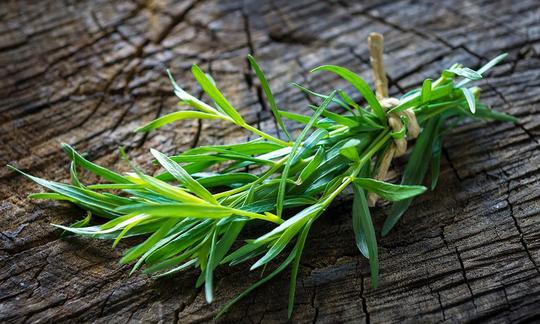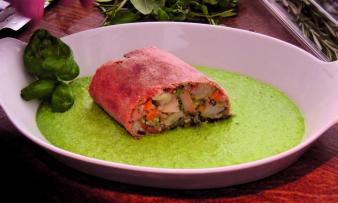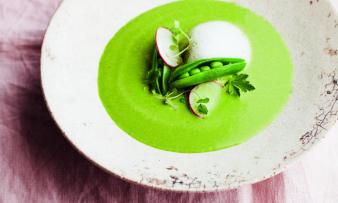Table of contents
Tarragon ( Artemisia dracunculus ) is often used in French cuisine. The fresh , raw herb (preferably organic ) not only flavors various sauces, but also salads and vegetable dishes.
Use in the kitchen
Tarragon is a widely used herb. Two varieties are particularly well-known: French tarragon (also known as real tarragon or German tarragon; Artemisia dracunculus var. sativa ) and Russian tarragon ( Artemisia dracunculus var. inodora ). They differ in both taste and appearance. What does tarragon taste like? French tarragon has a spicy, strong, delicate taste that is reminiscent of anise and a little of basil . Russian tarragon is slightly bitter and tart, and lacks the anise-like note. It has larger and generally greener leaves than the French variety, and is slightly larger overall. 1,2
Tarragon can be used fresh, dried and frozen. This article focuses on the use of fresh tarragon. You can find out more about dried tarragon in the related article.
To preserve the characteristic tarragon flavor, it should be added towards the end of a cooking process. 1 Are tarragon stalks edible? Leaves and twig tips are generally used, and the stalks are only used for flavoring if the cooking time is longer. The spice should be used sparingly, as too much tarragon suppresses other flavors.
What is tarragon used for? In France it is a popular herb that refines mustard and characterizes sauces such as bearnaise and hollandaise. Along with parsley , chives and chervil, tarragon is part of the classic French herb mixture "Fines Herbes". 2 The herb also gives vegan gravies, cream soups (e.g. with mushrooms) and omelettes a spicy taste. Tarragon is also often used to flavorherb vinegar and to season pickled cucumbers or carrots .
Can you eat tarragon raw? The raw herb is a component of fine dressings and livens up all kinds of salads, such as cucumber salad, spinach salad with asparagus and radishes , rocket salad or lentil salad (e.g. with braised radish ). The herb also works wonderfully in dips for raw vegetable sticks or over a vegan beetroot carpaccio.
Other uses for tarragon (fresh) include dishes with vegetables (e.g. in a vegetable stew with cauliflower , yellow bell peppers , tomatoes and sugar snap peas ), pasta (e.g. made into pesto), potatoes and rice . Very simple but excellent are mushrooms sautéed with garlic and tarragon. Also try the vegan vegetable strudel with Frankfurt green sauce .
With its aniseed-like taste, tarragon can also be used in desserts such as fruit salads, sorbets or creams. In Slovenia, it is an ingredient in the traditional pastry called potica (rolled yeast dough pastry). Tarragon is used in Armenia, Azerbaijan, Georgia, Russia, Estonia and Ukraine to flavour a sweet, non-alcoholic soft drink that gained popularity in the 1980s and is still popular today. In Georgia, it is called tarchuna or tarkhuna. 1
Because of its unique flavor, tarragon is difficult to replace, but the best options are rosemary (along with a few fennel seeds ), chervil (with a littlepepper ), oregano or parsley .
Are tarragon flowers edible? Tarragon flowers can be eaten, but they are rarely used in cooking. They are best enjoyed brewed as a tea.
Vegan recipe for leaf salad with melon and tarragon dressing
Ingredients (for 4 people): 250 g leaf salad (mixed), ½ cantaloupe melon , 1 shallot , 4-5 sprigs of tarragon (fresh, organic), 1 teaspoon mustard , 2 tablespoons white wine vinegar , 4 tablespoons rapeseed oil , ½ teaspoon agave syrup , a little salt andpepper .
Preparation: Wash the lettuce, spin dry and tear into bite-sized pieces. Remove the seeds from the melon, peel and cut into pieces. Peel and finely chop the shallot. Rinse the tarragon, shake dry and finely chop. Mix the mustard, white wine vinegar, rapeseed oil and agave syrup. Mix in the shallots and tarragon and season the dressing with salt and pepper. Mix the lettuce and melon pieces with the vegan tarragon dressing and serve.
Vegan recipes with fresh tarragon (raw) can be found under the note: " Recipes that have the most of this ingredient ".
| Not only vegans or vegetarians should read this: Vegans often eat unhealthily. Avoidable nutritional mistakes . |
Purchasing - Storage
In many large retailers (e.g. Coop , Denner , Volg , Spar , Aldi , Lidl , Hofer , Billa ) tarragon is mostly only available dried. A few supermarkets (e.g. Migros , Rewe , Edeka ) or organic supermarkets (e.g. Denn's Biomarkt , Alnatura ) occasionally offer fresh tarragon.
Fresh tarragon plants, mainly French varieties, are also available in garden centers.
The availability of fresh tarragon varies depending on the size of the store, catchment area, etc. Our recorded food prices for the DA-CH countries can be found above under the ingredient image - and by clicking on them you can see their development at various suppliers.
Storage tips
Fresh tarragon is best stored wrapped in a damp cloth in the vegetable compartment of the refrigerator. However, it should be used within a few days. Herb bunches will stay fresh for a few days if placed in a glass of water and look decorative. To do this, cut the stems like you would with cut flowers.
Can you dry or freeze tarragon? Although the herb is best used fresh, tarragon can be frozen or dried. It loses its flavor when dried, but dried tarragon will last for years if stored in a cool, dry place, protected from light and airtight.
Ingredients - Nutritional values - Calories
What are the important tarragon ingredients? 100 g of fresh tarragon (raw) has a calorie content of 60 kcal. There is little fat (1.1 g/100g). Carbohydrates make up 12 g/100g and the fiber content is 5.3 g/100g. 3
Fresh tarragon is rich in iron with 5.6 mg/100g (40% of the daily requirement). Fresh peppermint (5.1 mg/100g) and fresh parsley (6.2 mg/100g) contain a similar amount. Dried herbs contain significantly more iron, but you consume much less of it. Dried thyme contains 124 mg/100g and dried marjoram 83 mg/100g. 3
100 g of tarragon contains 0.5 mg of manganese (25% of the daily requirement). Fresh lemon balm (0.5 mg/100g) and fresh lovage (0.5 mg/100g) have a similar content. Fresh sage contains eight times as much manganese at 4 mg/100g. 3
The potassium content in tarragon (fresh) is 450 mg/100g (23% of the daily requirement). This is similar to that of fresh spearmint (458 mg/100g) and fresh lemon balm (400 mg/100g). Significantly more potassium can be found in fennel seeds (1694 mg/100g) and in dried herbs, such as coriander leaves with 4466 mg/100g or dill with 3308 mg/100g. 3
The complete ingredients of fresh tarragon (raw), the coverage of the daily requirement and comparison values with other ingredients can be found in our nutrient tables. In the article Nutrients explained you will get a detailed insight into the topic.
Health effects
Is tarragon healthy? The most important biologically active secondary plant substances in tarragon ( Artemisia dracunculus ) are essential oils, alkamides, coumarins, flavonoids and phenolic acids. Extracts and individual compounds of A. dracunculus have a wide range of pharmacological properties, including antibacterial, antifungal, anti-inflammatory and analgesic effects. Research has also shown antidiabetic and thyroid-regulating effects. According to studies, tarragon also has antioxidant, immunomodulatory and antineoplastic effects (effective against malignant tumors), protects the liver and stomach, and can be used to treat or prevent epileptic seizures. Documentation of an antidepressant effect is also known. 1,4,5,6,7
Dangers - Intolerances - Side effects
Estragole and methyleugenol, two main components of tarragon essential oil, have been shown to be toxic in some rodent studies. Other studies found no toxicity of tarragon extracts in mice. It was also found that the estragole content in the essential oil of the Russian variety is lower than that of the French variety. Water extracts of both tarragon varieties contain very low amounts of estragole and methyleugenol and are therefore safer than ethanolic extracts. 1,7,8
Overall, the risk of toxic effects for humans is considered to be low. Tarragon is normally used as a spice or tea, so the daily dose of dried plant parts is less than 10 g/day, which corresponds to safe amounts of estragole and methyl eugenol. 1 Nevertheless, pay attention to the recommended dose and duration of use and do not exceed these values.
The use of tarragon and its extracts is not recommended during pregnancy. 9,10
Folk medicine - naturopathy
In traditional medicine, tarragon is used for many ailments, but often to improve a poorly functioning digestive system and relieve digestive problems. 1,10 It is used in traditional Asian medicine as an analgesic, hypnotic (sleeping aid), antiepileptic, anti-inflammatory and antipyretic, and to treat worm infections. 4 The herb is also said to help with toothache and rheumatism. It also has a menstruation-stimulating effect, which is why tarragon is used when periods are late. 9,10
Ecological footprint - animal welfare
The CO2 footprint of a food depends on various factors. The type of agricultural production (conventional vs. organic), average or seasonal or regional production, domestic production or import by truck, ship or plane, different types of packaging and whether the goods are fresh or frozen all play a decisive role.
Fresh, unpackaged organic tarragon that has not been transported too far is preferable.
Worldwide occurrence - cultivation
Tarragon originates from areas in Siberia and Mongolia. Its distribution area extends across western North America, eastern and central Europe and most of temperate Asia. 1.4
The herb is grown on a large scale worldwide, mainly in southern Europe, Russia and the United States. 1.9
Found in the wild
In its natural habitats, tarragon is found in Central Asia, the Mediterranean countries, Eastern Europe and North America. The tarragon plant grows in meadows with alkaline soils, in birch forests, near rivers, on mountain slopes and in steppes. 4
Growing your own
Can you grow tarragon yourself? Tarragon can be planted in a bed in the garden or in a sufficiently large pot on the balcony - ideally in a sheltered, sunny to partially shaded location. Tarragon plants prefer humus-rich, permeable and moist soil with a neutral to slightly alkaline pH value. 11
The sensitive French tarragon cannot be propagated by sowing (it does not produce seeds), but only vegetatively. It is planted as a young plant in a bed or pot in April to May. The more resilient Russian tarragon can be sown from the end of April and only covered thinly with soil. 11
During long dry periods, the plants should be watered with plenty of water, but waterlogging should be avoided. Loosen the soil regularly so that the roots receive enough oxygen, and occasionally add organic fertilizer such as compost to provide the plants with nutrients. 11
Fresh leaves and shoot tips can be harvested all summer long. While the French variety is always equally aromatic, the Russian variety tastes most intensely during flower bud formation. 11
Further information
Tarragon ( Artemisia dracunculus ) is a plant species from the daisy family (Asteraceae). It is closely related to wormwood and mugwort (Artemisia family).
What does tarragon look like? The perennial plant reaches a height of up to one meter. It has lanceolate leaves and long, drooping inflorescences. 9
Alternative names
The following alternative names are known: Biertram, Bertram, Drachant, Dragon, Dragackel, Dragunten, Eierkraut, Escadronkraut, Fieferkrott, Kaisersalat, Traben and Zittwerkraut. In English the herb is called tarragon.
What is the meaning of tarragon? According to Pliny the Elder (1st century AD), the plant was given the species name A. dracunculus because of its snake-shaped rhizomes - dracunculus is a diminutive of the Latin word "draco" (dragon) and means little dragon. It was supposed to protect against snake bites when worn on the body or consumed as a drink. The name A. dracunculus could also be a distorted version of the Arabic name for tarragon (tarragon), namely tharchum, from which the synonyms tarchon, tarcon and torchun are derived. 4
Other uses
In addition to being used as a spice and medicinal plant, tarragon is used in the production of cosmetics, perfumes and detergents. Essential oils, extracts from flowers, leaves, stems and seeds as well as from the whole herb and roots are used for this purpose. The essential oil is also used in aromatherapy. 4,10










Comments